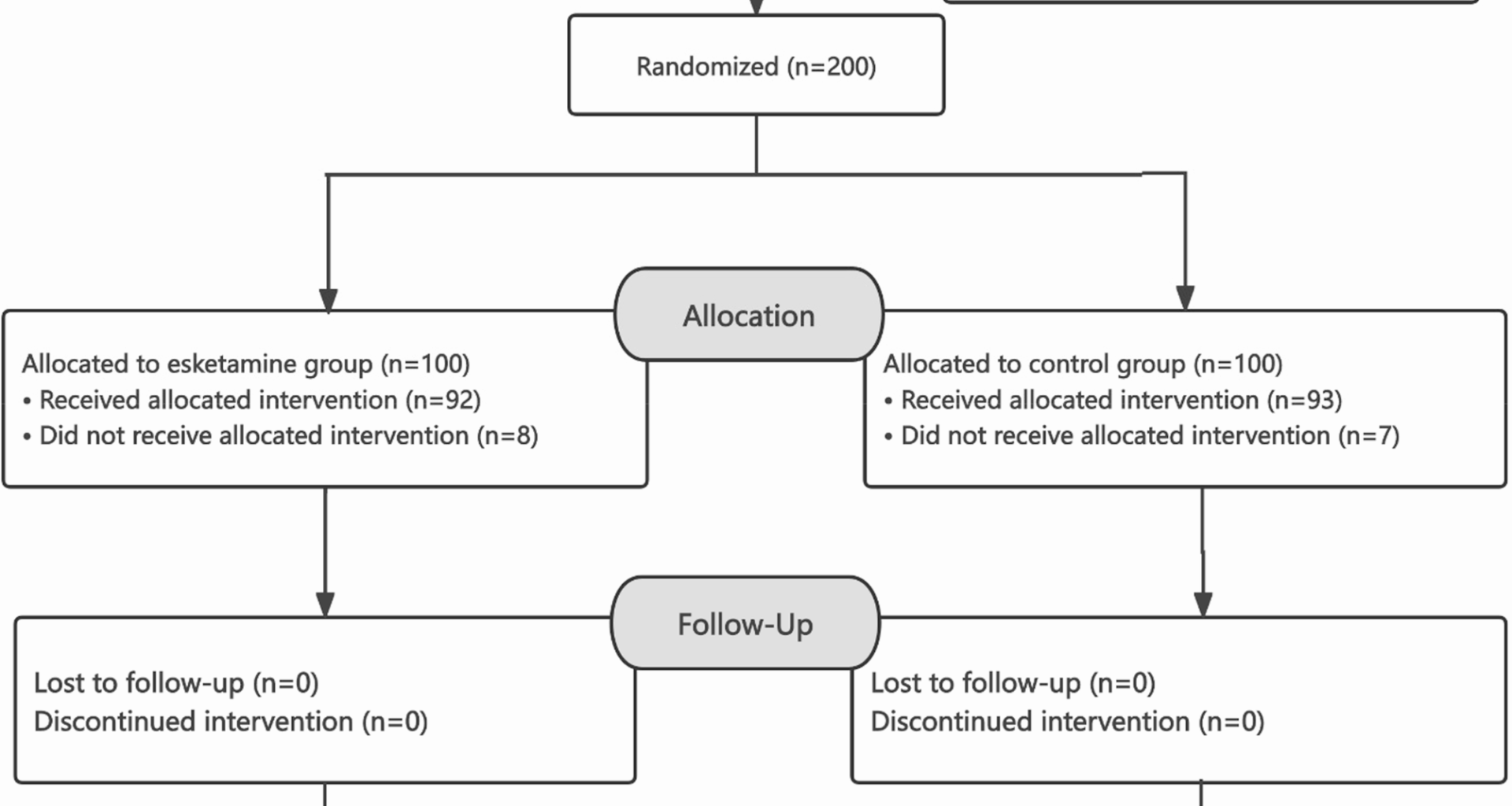In this randomized, double-blind trial, we demonstrated that adjunctive low-dose esketamine (0.2 mg/kg) with standard propofol-opioid induction significantly reduced the incidence of hemodynamic instability during anesthesia induction in elderly patients undergoing gastrointestinal surgery. The esketamine group maintained more stable SBP, MAP, and HR, preserved cardiac output, and required less ephedrine than the control group, highlighting improved cardiovascular stability without increasing adverse recovery events. Esketamine also reduced the incidence of intubation-related coughing, contributing to a smoother induction process.
Previous studies have reported that hypotension during anesthesia induction is common, particularly in elderly patients, and is associated with adverse outcomes such as myocardial ischemia, acute kidney injury, and increased postoperative morbidity and mortality. [23,24,25,26,27,28,29]. In our study, hemodynamic instability occurred in 55.9% of control patients, compared with 29.3% in the esketamine group, highlighting the stabilizing effect of adjunctive low-dose esketamine. This reduction may be attributed to esketamine’s sympathomimetic properties, which increase circulating norepinephrine and support cardiovascular function, as reflected in the lower frequency and dosage of ephedrine required in the esketamine group [30, 31].
In the control group, we observed pre-intubation hypotension followed by post-intubation increases in SBP and MAP, accompanied by transient heart rate changes and higher ephedrine use. Transthoracic echocardiography revealed a concomitant decline in cardiac output in this group, despite similar MAPs, whereas CO remained stable in the esketamine group. These findings indicate that blood pressure alone may not reliably reflect perfusion and underscore the benefit of esketamine in preserving forward flow during induction, particularly in elderly patients with reduced cardiovascular reserve and potential fluid deficits [4].
Transthoracic echocardiography, a validated noninvasive method for assessing cardiac output (CO) in perioperative settings [32], revealed that although both groups experienced comparable reductions in SBP and MAP prior to intubation, only the control group showed a significant decline in CO. In contrast, CO in the esketamine group remained stable throughout induction. The control group also required nearly twice as much ephedrine as the esketamine group (24.7% vs. 12.0%) to manage hypotension. Notably, despite restoring arterial pressure, vasoactive agents did not fully normalize forward flow, as evidenced by persistently lower CO values in the control group at 3 and 5 minutes after intubation. These findings highlight that blood pressure alone may not reliably reflect perfusion, particularly in elderly patients at risk for end-organ hypoperfusion, and support the use of continuous or point-of-care CO monitoring during induction.
Esketamine’s ability to preserve CO appears to result primarily from its sympathomimetic properties, including inhibition of norepinephrine reuptake, increased systemic vascular resistance, and enhanced cardiac contractility [16,17,18, 20]. These actions counteract the vasodilatory and myocardial depressant effects of propofol, maintaining forward flow and stabilizing hemodynamics. In our study, CO remained significantly higher in the esketamine group at T2–T4, despite comparable fluid management. Heart rate increases were modest and clinically acceptable, suggesting a favorable balance between sympathetic stimulation and autonomic control. In contrast, the control group exhibited transient post-intubation tachycardia, likely reflecting compensatory sympathetic activation. Prior studies have shown that esketamine can increase CO by up to 25% at plasma concentrations of approximately 1.7 μmol/L without provoking reflex tachycardia [33, 34], consistent with our findings.
Although ketamine derivatives have raised concerns about delayed emergence and postoperative delirium, emerging evidence supports the safety of low-dose esketamine. In our study, a single bolus of 0.2 mg/kg esketamine did not prolong extubation or emergence times, nor did it increase the incidence of emergence agitation or delirium. These findings align with previous reports in both pediatric and elderly populations. For instance, a randomized trial in children undergoing tonsillectomy reported a reduction in emergence agitation (5% vs. 27.5%) without prolonging extubation time following 0.25 mg/kg esketamine at the end of surgery [35]. In elderly patients undergoing hip or knee arthroplasty, perioperative low-dose esketamine (0.2 mg/kg loading, 0.125 mg/kg/h infusion) did not increase postoperative delirium or recovery times, and adverse psychomimetic effects were rare [36]. Similarly, in elderly gastrointestinal surgery patients, low-dose esketamine improved postoperative analgesia and reduced inflammatory markers such as IL-6 without increasing nausea, vomiting, nightmares, or delirium [37]. Collectively, these data indicate that low-dose esketamine during induction provides hemodynamic and analgesic benefits without compromising recovery or cognitive outcomes, whereas higher doses or prolonged infusions may pose risks, highlighting the need for careful dose optimization in elderly surgical patients.
Individual responses to S-ketamine may vary, and certain patients may benefit more than others. In elderly patients undergoing gastrointestinal surgery, factors such as reduced cardiovascular reserve, impaired baroreflex sensitivity, baseline sympathetic tone, and preoperative fluid deficits—exacerbated by prolonged fasting and bowel preparation—predispose some patients to greater hemodynamic fluctuations. Patients with lower baseline catecholamine reserves or diminished autonomic compensation are more likely to experience hypotension and may therefore derive greater benefit from the sympathomimetic properties of S-ketamine, which increase circulating norepinephrine, enhance vascular tone, and support cardiac contractility. Age-related pharmacokinetic changes, such as reduced hepatic clearance, may further modify individual hemodynamic responses.
This study has several limitations. First, we did not assess markers of organ perfusion compromise (e.g., lactate, creatinine, or myocardial enzymes), which limits our ability to directly link improved hemodynamic stability to organ protection. Second, our analysis focused exclusively on the induction period, without evaluating the effects of esketamine during anesthesia maintenance, late emergence, or on long-term organ outcomes. Although low-dose esketamine reduced induction-related hemodynamic instability, we did not determine whether this translated into lower rates of postoperative cardiac, renal, or neurological complications. Prior studies have shown that even brief but severe hypotension during induction is associated with increased risks of myocardial injury, acute kidney injury, stroke, and mortality [28, 29, 38]. Finally, our single-dose design leaves open the question of whether continuous infusion or higher dosing could provide additional benefit or increase adverse effects. Future studies should investigate optimal dosing strategies and long-term outcomes, particularly in high-risk elderly patients.
